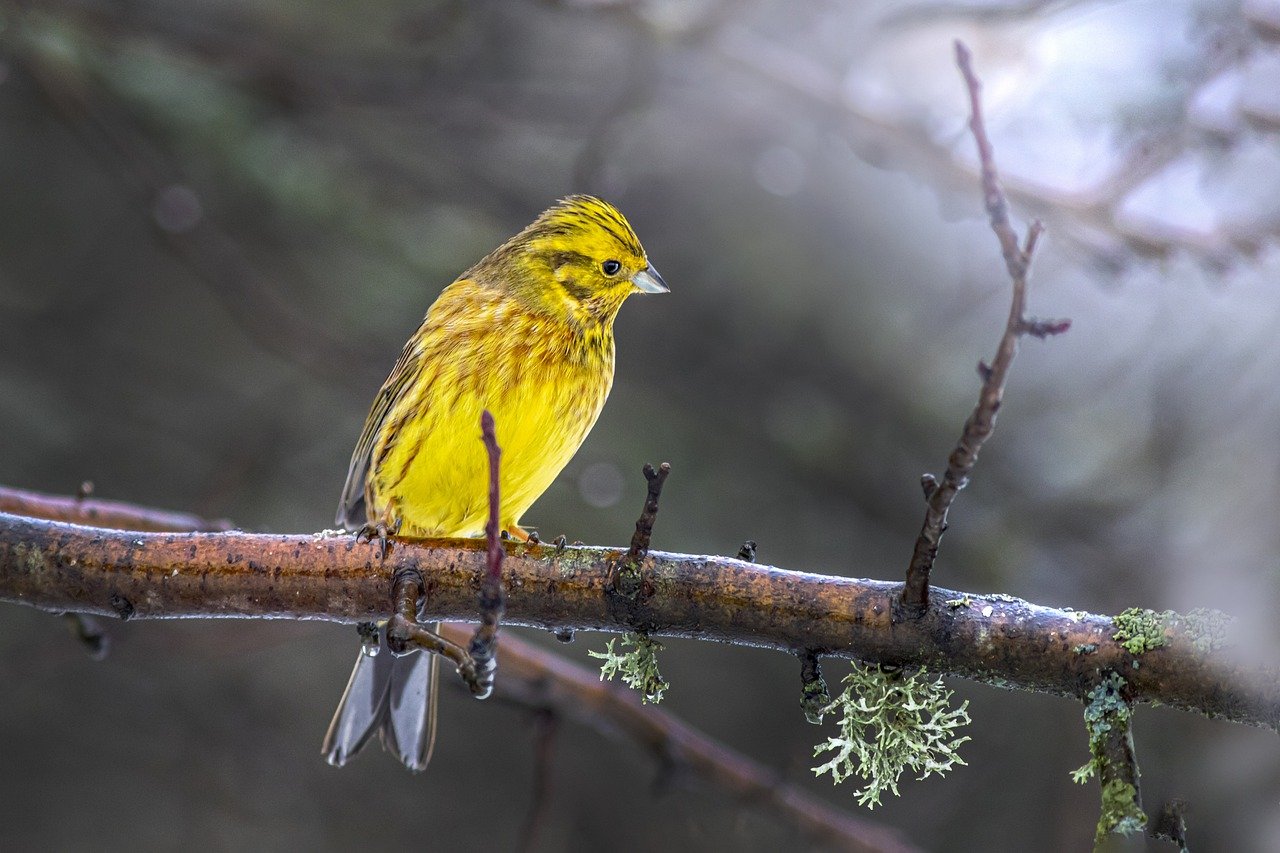The Yellowhammer (Emberiza citrinella) is a brightly colored and easily recognizable passerine bird found across Europe and parts of Asia. Known for its vivid yellow plumage and distinctive song, it is a familiar sight in various habitats.
Description
- Appearance:
- Size: The Yellowhammer measures approximately 15-16 centimeters (5.9-6.3 inches) in length with a wingspan of about 22-26 centimeters (8.7-10.2 inches).
- Coloration:
- Males: The male Yellowhammer is strikingly colorful with bright yellow underparts, a yellow belly, and a contrasting brown streaked back. The head is often a warm yellow with a darker crown.
- Females: Females are more subdued in coloration, with a generally brown and streaked appearance that offers better camouflage.
- Bill: They have a short, conical bill that is adapted for their seed-based diet.
Habitat
- Distribution: The Yellowhammer is found throughout Europe, from the Iberian Peninsula in the west to the Ural Mountains in the east. It is also present in parts of North Africa and has been introduced to some other regions.
- Preferred Environment: They inhabit a range of open and semi-open environments including farmland, hedgerows, woodland edges, and rural areas. They are often seen in agricultural landscapes where they forage for seeds.
Behavior and Ecology
- Diet:
- Granivorous: The diet of Yellowhammers primarily consists of seeds, including those of grasses, cereals, and weeds. During the breeding season, they also consume insects and other invertebrates to provide protein for their young.
- Foraging: They are often seen foraging on the ground or in low vegetation, where they peck at seeds and other food sources.
- Breeding:
- Nesting: Yellowhammers build their nests on or near the ground in dense grass or low shrubs. The nests are usually made from grasses, twigs, and leaves, lined with feathers and other soft materials.
- Incubation: The female incubates the eggs for about 11-13 days. After hatching, both parents feed the chicks, which fledge around 12-15 days after hatching.
- Behavior:
- Song: The song of the male Yellowhammer is a distinctive and repetitive “a little bit of bread and no cheese,” often sung from an elevated perch. This song is used to defend territory and attract mates.
- Social Structure: Outside the breeding season, Yellowhammers often form loose flocks, particularly in areas with abundant food sources.
Conservation
- Status: The Yellowhammer is currently not considered endangered, but its populations have experienced declines in some areas due to habitat loss and changes in agricultural practices.
- Conservation Efforts: Conservation efforts focus on maintaining and restoring suitable habitats, particularly through practices that support the survival of hedgerows and agricultural landscapes that are favorable to the species.
Observing Yellowhammers
- Best Times: Yellowhammers can be observed throughout the year, but they are most active and visible during the breeding season in spring and summer.
- Watching Tips: Look for them in agricultural fields, hedgerows, and grassy areas. Their distinctive song and bright yellow plumage make them relatively easy to spot once you are in their habitat.
Interesting Facts
- Song Variability: The song of the Yellowhammer varies regionally, with different populations having slightly different song patterns.
- Cultural Significance: The Yellowhammer’s song is referenced in traditional English folk songs and proverbs, highlighting its cultural presence in the regions where it is common.
- Adaptability: The species has shown adaptability to various agricultural practices, although modern changes in farming techniques can still impact its habitat.
Summary
The Yellowhammer (Emberiza citrinella) is a vibrant and distinctive bird known for its bright yellow plumage and characteristic song. Found across Europe and parts of Asia, it thrives in open and semi-open landscapes, including farmland and hedgerows. Its adaptability to various habitats and its striking appearance make it a favorite among bird watchers and nature enthusiasts. Conservation efforts aim to support this species by preserving and enhancing its natural habitats. across its range.
Views: 1330
Subscribe to the newsletter:
